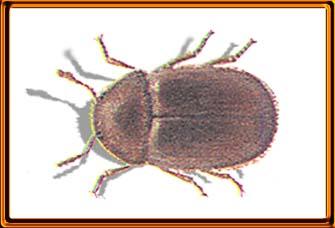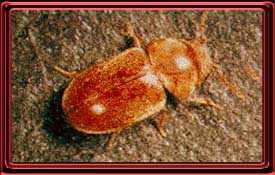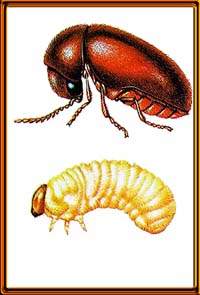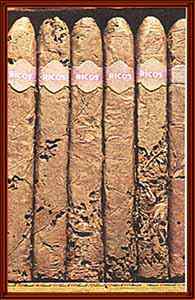
(Cigarette or Tobacco Beetle)
Like the drugstore beetle the tobacco beetle is also related to the furniture beetle. Adult cigarette beetles are yellowish- to reddish-brown, oval-shaped, and about 1/10-inch long. The head is bent downward sharply, nearly at right angles to the body, giving a humpbacked appearance when viewed from the side. The wing covers (elytra) are smooth, and the antennal segments are uniform and saw-like (serrate). Looking at the pictures below will aid identification:

 Biscuit Beetle Cigarette Beetle
Biscuit Beetle Cigarette BeetleTo illustrate how sharply the head is bent down
Some Biology:
Female cigarette beetles lay about 30 eggs in a period of 3 weeks. Eggs hatch in 6 to 10 days. The larval stage lasts from 5 to 10 weeks with larvae shunning light. The pupal and prepupal periods last 2 to 3 weeks and are passed in a cell. The life cycle lasts from 70 to 90 days, and there may be 5 to 6 overlapping generations per year in warm localities with only one generation in the more temperate regions. Adults are strong flyers and active in subdued light at temperatures above 65°F. Adult beetles may live from 23 to 28 days. In temperate climates, beetles begin swarming in May and again in August. Overwintering may be passed in the larval stage, with some adults not too resistant to cold hibernating in crevices. In warehouses, the life cycle may be completed in 52 days.
Preferred Habitat:
Cigarette beetles commonly infest dried tobacco and tobacco products - hence their name. They also infest raisins, figs, dates, ginger, pepper, nutmeg, chili powder, curry powder, cayenne pepper, paprika, yeast, drugs, legume seeds, barley, cornmeal, flour, soybean meal, sunflower meal, wheat, wheat bran, rice meal, beans, cereals, fish meal, peanuts, dry yeast, dried flowers, leather, woolen cloth, and bamboo. They also may damage the leaves and bindings of books when feeding on the paste, or overstuffed furniture when infesting the straw, hair, etc.
Looks like the tobacco beetle got there first..!
Referral back to the biscuit beetle page will enable a comparison between the three types of beetle.
Control:
Control of this pantry pest begins with the location of the infested food. A thorough clean up, using a vacuum cleaner to get into the cracks and crevices, will control this pest. Also be aware that if there are any bread items which have been varnished and used for display purposes in the kitchen, that these will be an ideal harbourage area.
Again in an industrial situation, things should not have got to the point where there is a problem, vigilance at all times, and scrupulous housekeeping is the only way to maintain a pest free environment.

